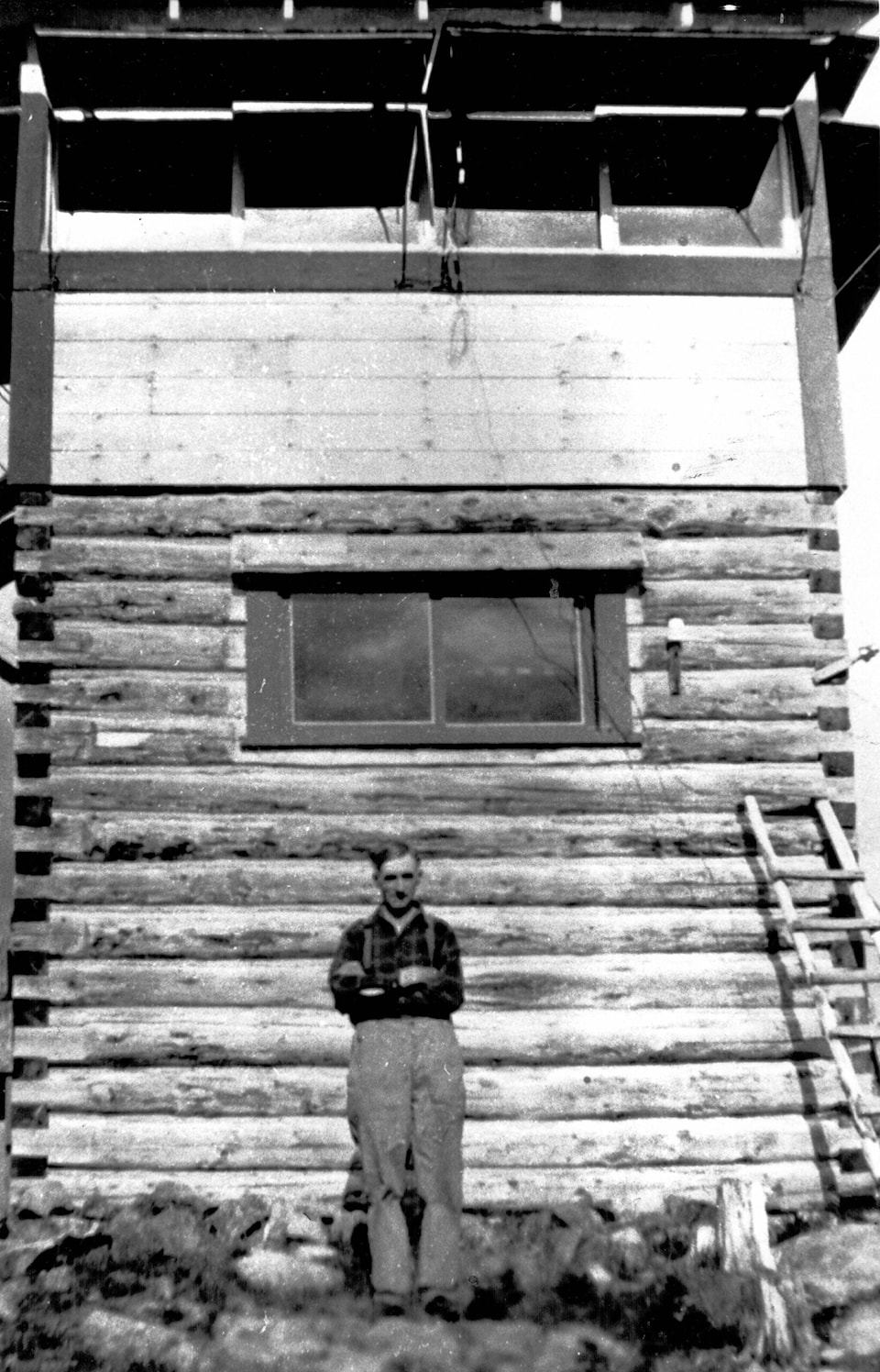Before the age of satellite imagery, BC Forest Service lookouts like the one on Boer Mountain, northeast of Burns Lake, played a key role in wildfire suppression. Each summer, Forest Service employees lived on site and kept watch for plumes of smoke, which they then reported to fire suppression crews.
The first lookout stations here were rudimentary in design. In 1929, the facility on Priestly Hill bore a striking resemblance to the crow’s nest of a sailing ship. The tiny viewing platform, thirty or forty feet above the ground and accessible only by ladder, had no railings and was barely large enough to accommodate a man standing. The nearby living accommodations, which consisted of a wall tent, also left something to be desired.
By the 1940s, most of the early lookout stations had been replaced by larger log structures that included living quarters. The job, however, remained essentially the same.
It was lonely and, at times, dangerous work. By virtue of their location, the lookouts were buffeted by high winds and freak storms; being the highest points for miles around, they were regularly struck by lightning. Yet the people charged with keeping watch over the forests from these isolated viewpoints had to contend with more than extreme weather. Pete Jensen saw grizzly tracks the size of dinner plates near his post on Dina Mountain in the 1950s, while Sam and Janet Shaffer, who spent their summers on Boer Mountain from 1973 to 1983, recalled a colleague who struggled with another four-legged visitor.
“One night, a porcupine was chewing on the boards on the floor underneath the building, and he [the lookout man] couldn’t get to sleep,” recalled Janet in the late 1980s. “He’d get up and jump on the floor, and it would be quiet, and as soon as [he] got back into bed, it started again. Chomp, chomp, chomp. So, he turned the radio on, and figured, well, the porcupine could listen to the radio. All he could get was this squawky music, this new rock music, so he thought, well, if he didn’t like it, maybe the porcupine wouldn’t. So, he turned the little radio up full blast and set it right on top of where the porcupine was. [He] let it blare for about a half an hour, and then shut it off and listened. Apparently, the porcupine couldn’t stand it either; he left and never did come back.”
As recently as the 1950s, there were seven active lookouts in the Lakes District. In addition to Jensen and the Shaffers, men and women like Jack Mowat, A. L. Chadwick, Dave L. Murray, Pete Tourond, Roy Minger, and (in 1970) Charlie Beatty kept watch from towers strategically positioned around the Lakes District.
The starting salary for a lookout man at that time was $250. The money wasn’t great, but the job’s intangible benefits kept watchkeepers coming back year after year. Tourond spent twenty-two summers on the lookouts, seventeen of them at Parrott Mountain, and Murray did the job for at least a decade and a half.
“Murray was my great-uncle,” said Karen Haugen in 2021. “We visited Parrott Mountain with [my] grandparents, Hugh and Sarah Cowan. As a child, it was an exciting place—and the huckleberries were awesome.”
For a person who liked solitude and didn’t require a lot of money, it must have been a joy. Many of the men were bachelors, and most kept themselves busy with hobbies like photography, rockhounding, and oil painting. Jensen crocheted, and every fire season, completed a new tablecloth.
Although some lookouts, such as the one on Verdun Mountain south of Francois Lake, are still used, the province now relies primarily on sophisticated computer programs to monitor lightning strikes and wildfire activity from the sky. Most of the old lookouts are deactivated, but a few—including the Buchanan Lookout northwest of Kaslo, and the Thornhill Lookout near Terrace—are now open to self-guided tours. Several have been turned over to local communities, and now serve as recreation facilities.
© 2021 Lakes District Museum Society
